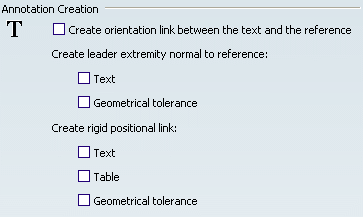Annotation and Dress-Up | ||||
|
| |||
Annotation Creation

Important:
|
- Create orientation link between the text and the reference
-
Select this check box if you want to create annotation texts along a reference direction. For example, if you select a line when creating a text, the text will be oriented parallel to the line.
 By default,
this option is not selected.
By default,
this option is not selected. - Create leader extremity normal to reference: Text
-
Select this check box if you want to create the extremity of text leaders normal to a reference direction. For example, if you select a line when creating a text with leader, the leader will be normal to the line.
 By default,
this option is not selected.
By default,
this option is not selected. - Create leader extremity normal to reference: Geometrical Tolerance
-
Select this check box if you want to create the extremity of geometrical tolerance leaders normal to a reference direction. For example, if you select a line when creating a geometrical tolerance, the leader will be normal to the line.
 By default,
this option is not selected.
By default,
this option is not selected. - Create rigid positional link: Text
-
Select this check box to create rigid positional links for texts whenever new positional links are created.
 By default,
this option is not selected.
By default,
this option is not selected. - Create rigid positional link: Table
-
Select this check box to create rigid positional links for tables (between a table and its reference element) whenever new positional links are created.
 By default,
this option is not selected.
By default,
this option is not selected. - Create rigid positional link: Geometrical Tolerance
-
Select this check box to create rigid positional links for geometrical tolerances.
 By default,
this option is not selected.
By default,
this option is not selected.
![]()
Move

| Important: If Snap by default is selected, and Create orientation link between the text and the reference is cleared, orientation links will not be created. |
- Configure snapping
-
Click Configure Snapping to define how snapping should be performed in the Annotation Snapping dialog box. Refer to Annotation Snapping Dialog Box for more information.
This will apply to the annotations selected in the Annotation Creation area.
- Snap by default (SHIFT toggles)
-
Select this check box to activate snapping by default when creating or handling annotations. Pressing the Shift key will enable you to temporarily deactivate snapping. Note that snapping is performed according to the options set in the Annotation Snapping Dialog Box.
With this option clear, snapping is not active. In this case, pressing the Shift key will enable you to temporarily activate it.
 By default,
this option is selected.
By default,
this option is selected.
![]()
2D Component

- Create with a constant size
-
Select this check box if you want all 2D component instances to have the same size when you create them, no matter what the view scale is. You can use them as symbols, for example.
Tip: If you want to use 2D components with text as symbols, activate both the Create with a constant size setting and the Apply Scale property for the text (in Edit > Properties): the size of both the 2D component and its text will then be independent from the view scale.  By default,
this option is not selected.
By default,
this option is not selected. - Disable direct manipulation
-
Select this check box to prevent moving or rotating 2D components using the pointer.
 By default,
this option is not selected.
By default,
this option is not selected. - Disable direct scaling
-
Select this check box to prevent scaling 2D components using the pointer.
 By default,
this option is not selected.
By default,
this option is not selected.
![]()
Table

- Recompute table when editing cell
-
Select this check box if you want a table to be resized while you are editing a cell. If it is not selected, the table is resized after closing the Text Editor.
 By default,
this option is selected.
By default,
this option is selected. - Do not split table on several sheets
-
Important: This option is available only when certain licenses are installed.
With certain licenses, tables are split automatically on several sheets. Select this check box if you want to keep tables on a single sheet.
 By default,
this option is selected.
By default,
this option is selected.
![]()
Area Fill

- Ask for deletion of geometry support
-
Select this check box if you want a message to appear each time you delete an area fill, prompting you to specify whether or not you want to delete the area fill support geometry.
When this option is clear, the message does not appear and the area fill support geometry is not deleted.
Important: When deleting isolated area fills, this message does not appear, as there is no support geometry to delete.  By default,
this option is selected.
By default,
this option is selected. - Area Fill detection optimized for geometry: Generated or sketched
-
Select this option when creating area fills mainly on generated or sketched geometries, to define the tolerance mode allowed when creating an area fill profile.
 By default,
this option is selected.
By default,
this option is selected. - Area Fill detection optimized for geometry: Imported from external format
-
Select this option when creating area fills mainly on views imported from external formats, to define the tolerance mode allowed when creating an area fill profile.
 By default,
this option is not selected.
By default,
this option is not selected.